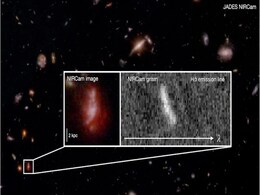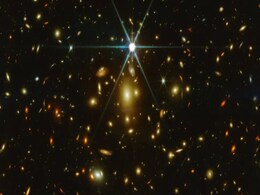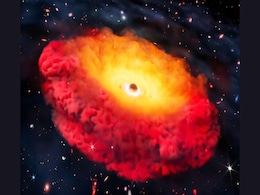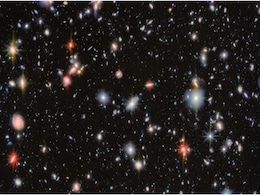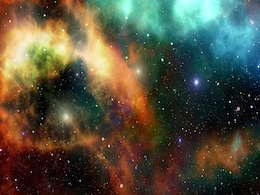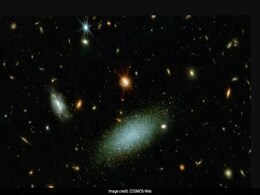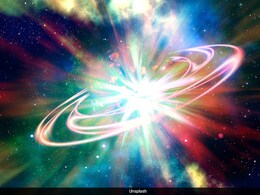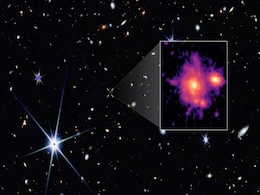Big Bang Telescopes
- All
- News
-

NASA May Have Detected Oldest Stars In Universe Formed After Big Bang
- Friday November 21, 2025
- Feature | Edited by Abhinav Singh
NASA's James Webb Space Telescope may have detected the universe's oldest Population III stars in galaxy LAP1-B, 13 billion light-years away.
-
 www.ndtv.com
www.ndtv.com
-

James Webb Space Telescope May Have Spotted the Universe’s First Stars, Astronomers Say
- Wednesday November 19, 2025
- Written by Gadgets 360 Staff
Astronomers using the James Webb Space Telescope have detected a distant, metal-poor galaxy whose unusually massive, ultraviolet-bright stars match the expected signatures of Population III — the universe’s first stars. Through the help of gravitational lensing and Webb’s infrared sensitivity, researchers observed light from just 800 million ...
-
 www.gadgets360.com
www.gadgets360.com
-

How Hot Was the Universe 7 Billion Years Ago? Scientists Now Have an Answer
- Wednesday November 5, 2025
- Written by Gadgets 360 Staff
Japanese astronomers using ALMA data have found the universe was about twice as hot 7 billion years ago, with a temperature of 5.13 K compared to today’s 2.7 K. The finding aligns perfectly with Big Bang predictions that the Universe cools as it expands, providing the most precise mid-epoch measurement yet and reinforcing confidence in standard c...
-
 www.gadgets360.com
www.gadgets360.com
-

James Webb Telescope Uncovers the Turbulent Birth of the First Galaxies
- Saturday October 25, 2025
- Written by Gadgets 360 Staff
Using JWST data, astronomers analyzed more than 250 galaxies from the universe’s first 1.5 billion years and found most were chaotic, with gas swirling in all directions. Only a few showed early signs of ordered rotation. The findings reveal how intense star formation and gravitational turbulence gave way to stability, transforming the early univ...
-
 www.gadgets360.com
www.gadgets360.com
-

Earendel: JWST Suggests the Most Distant Star May Be a Star Cluster
- Thursday August 21, 2025
- Written by Gadgets 360 Staff
Earendel, the farthest object ever seen, was first thought to be a single massive star from the early universe. New findings from JWST suggest it may instead be a star cluster, with many stars grouped together. Scientists used gravitational lensing to spot Earendel, which made its light appear thousands of times brighter.
-
 www.gadgets360.com
www.gadgets360.com
-

Earliest Known Black Hole Found Just 500 Million Years After the Big Bang
- Friday August 8, 2025
- Written by Gadgets 360 Staff
Astronomers have confirmed the most distant black hole ever discovered, lurking in a compact galaxy just 500 million years after the Big Bang. Using the James Webb Space Telescope, the team identified clear spectroscopic evidence of the object, offering new insight into early black hole growth and their role in forming galaxies during the universe...
-
 www.gadgets360.com
www.gadgets360.com
-

James Webb Space Telescope Reimagines Hubble’s Deep Field, Unveils Ancient Galaxies
- Tuesday August 5, 2025
- Written by Gadgets 360 Staff
The James Webb Space Telescope has re-imaged part of Hubble’s Ultra Deep Field, revealing over 2,500 galaxies in stunning infrared detail. Using its NIRCam and MIRI instruments, Webb observed faint galaxies dating back to just a few hundred million years after the Big Bang. This is part of the JADES survey, which includes the deepest mid-infrared...
-
 www.gadgets360.com
www.gadgets360.com
-

Radio Signal from Early Universe May Reveal the Masses of the First Stars
- Sunday June 22, 2025
- Written by Gadgets 360 Staff
A newly modelled 21-centimetre radio signal from hydrogen atoms just 100 million years after the Big Bang may reveal the mass of the universe’s first stars. Using REACH and the upcoming SKA telescopes, researchers aim to uncover how early starlight shaped cosmic evolution during the Cosmic Dawn, when the universe transitioned from darkness to lig...
-
 www.gadgets360.com
www.gadgets360.com
-

James Webb Telescope Unveils Largest-Ever Map Of The Universe, Reveals 800,000 Galaxies
- Thursday June 12, 2025
- Science | Edited by Ritu Singh
Spanning 98% of the universe's timeline, this comprehensive dataset was made possible by the James Webb Space Telescope's 255 hours of observation.
-
 www.ndtv.com
www.ndtv.com
-

Scientists Observe Light Of "Cosmic Dawn" With Telescope On Earth For The First Time Ever
- Thursday June 12, 2025
- Science | Edited by Srishti Singh Sisodia
Cosmic dawn insights shed light on the universe's early stages, providing an understanding of the universe's origins.
-
 www.ndtv.com
www.ndtv.com
-

NASA’s Chandra Spots Unexpectedly Strong Jet from Distant Black Hole at Cosmic Noon
- Wednesday June 11, 2025
- Written by Gadgets 360 Staff
NASA’s Chandra telescope has spotted two powerful black hole jets from over 11.6 billion light-years away. Detected during the universe’s cosmic noon, these jets reveal rare high-speed behaviour boosted by Big Bang remnants. The findings, which factor in relativistic effects, shed new light on early black hole growth and will be published in Th...
-
 www.gadgets360.com
www.gadgets360.com
-

NASA James Webb Space Telescope Discovers Farthest Spiral Galaxy, Reveals Clues About Galactic Evolution
- Saturday April 19, 2025
- Written by Gadgets 360 Staff
JWST discovers Zhúlóng, the earliest Milky Way-like galaxy, 800 million years after the Big Bang explosion occurred.
-
 www.gadgets360.com
www.gadgets360.com
-

What Is Dark Energy? The Mystery Behind The Expanding Universe
- Thursday March 20, 2025
- World News | Agence France-Presse
Dark energy makes up roughly 70 percent of the universe, yet we know nothing about it. Around 25 percent of the universe is the equally mysterious dark matter, leaving just five percent for everything that we can see and touch.
-
 www.ndtv.com
www.ndtv.com
-

Water May Have Formed in the Universe 100 Million Years After Big Bang
- Thursday March 13, 2025
- Written by Gadgets 360 Staff
A new study suggests water formed in the universe just 100–200 million years after the Big Bang, much earlier than previously estimated. Researchers examined ancient supernovas to understand how oxygen combined with hydrogen to create water. If confirmed, these findings could change perspectives on when the conditions for life first emerged. The ...
-
 www.gadgets360.com
www.gadgets360.com
-

SPHEREx Space Telescope to Map Cosmos in Infrared Light, Launching in February 2025
- Tuesday February 4, 2025
- Written by Gadgets 360 Staff
Set to launch in February 2025, NASA’s SPHEREx mission will provide a comprehensive map of the universe in infrared light. The telescope will examine 450 million galaxies and 100 million stars, shedding light on the universe’s formation, early conditions after the Big Bang, and the presence of water in planetary systems. SPHEREx will survey the...
-
 www.gadgets360.com
www.gadgets360.com
-

NASA May Have Detected Oldest Stars In Universe Formed After Big Bang
- Friday November 21, 2025
- Feature | Edited by Abhinav Singh
NASA's James Webb Space Telescope may have detected the universe's oldest Population III stars in galaxy LAP1-B, 13 billion light-years away.
-
 www.ndtv.com
www.ndtv.com
-

James Webb Space Telescope May Have Spotted the Universe’s First Stars, Astronomers Say
- Wednesday November 19, 2025
- Written by Gadgets 360 Staff
Astronomers using the James Webb Space Telescope have detected a distant, metal-poor galaxy whose unusually massive, ultraviolet-bright stars match the expected signatures of Population III — the universe’s first stars. Through the help of gravitational lensing and Webb’s infrared sensitivity, researchers observed light from just 800 million ...
-
 www.gadgets360.com
www.gadgets360.com
-

How Hot Was the Universe 7 Billion Years Ago? Scientists Now Have an Answer
- Wednesday November 5, 2025
- Written by Gadgets 360 Staff
Japanese astronomers using ALMA data have found the universe was about twice as hot 7 billion years ago, with a temperature of 5.13 K compared to today’s 2.7 K. The finding aligns perfectly with Big Bang predictions that the Universe cools as it expands, providing the most precise mid-epoch measurement yet and reinforcing confidence in standard c...
-
 www.gadgets360.com
www.gadgets360.com
-

James Webb Telescope Uncovers the Turbulent Birth of the First Galaxies
- Saturday October 25, 2025
- Written by Gadgets 360 Staff
Using JWST data, astronomers analyzed more than 250 galaxies from the universe’s first 1.5 billion years and found most were chaotic, with gas swirling in all directions. Only a few showed early signs of ordered rotation. The findings reveal how intense star formation and gravitational turbulence gave way to stability, transforming the early univ...
-
 www.gadgets360.com
www.gadgets360.com
-

Earendel: JWST Suggests the Most Distant Star May Be a Star Cluster
- Thursday August 21, 2025
- Written by Gadgets 360 Staff
Earendel, the farthest object ever seen, was first thought to be a single massive star from the early universe. New findings from JWST suggest it may instead be a star cluster, with many stars grouped together. Scientists used gravitational lensing to spot Earendel, which made its light appear thousands of times brighter.
-
 www.gadgets360.com
www.gadgets360.com
-

Earliest Known Black Hole Found Just 500 Million Years After the Big Bang
- Friday August 8, 2025
- Written by Gadgets 360 Staff
Astronomers have confirmed the most distant black hole ever discovered, lurking in a compact galaxy just 500 million years after the Big Bang. Using the James Webb Space Telescope, the team identified clear spectroscopic evidence of the object, offering new insight into early black hole growth and their role in forming galaxies during the universe...
-
 www.gadgets360.com
www.gadgets360.com
-

James Webb Space Telescope Reimagines Hubble’s Deep Field, Unveils Ancient Galaxies
- Tuesday August 5, 2025
- Written by Gadgets 360 Staff
The James Webb Space Telescope has re-imaged part of Hubble’s Ultra Deep Field, revealing over 2,500 galaxies in stunning infrared detail. Using its NIRCam and MIRI instruments, Webb observed faint galaxies dating back to just a few hundred million years after the Big Bang. This is part of the JADES survey, which includes the deepest mid-infrared...
-
 www.gadgets360.com
www.gadgets360.com
-

Radio Signal from Early Universe May Reveal the Masses of the First Stars
- Sunday June 22, 2025
- Written by Gadgets 360 Staff
A newly modelled 21-centimetre radio signal from hydrogen atoms just 100 million years after the Big Bang may reveal the mass of the universe’s first stars. Using REACH and the upcoming SKA telescopes, researchers aim to uncover how early starlight shaped cosmic evolution during the Cosmic Dawn, when the universe transitioned from darkness to lig...
-
 www.gadgets360.com
www.gadgets360.com
-

James Webb Telescope Unveils Largest-Ever Map Of The Universe, Reveals 800,000 Galaxies
- Thursday June 12, 2025
- Science | Edited by Ritu Singh
Spanning 98% of the universe's timeline, this comprehensive dataset was made possible by the James Webb Space Telescope's 255 hours of observation.
-
 www.ndtv.com
www.ndtv.com
-

Scientists Observe Light Of "Cosmic Dawn" With Telescope On Earth For The First Time Ever
- Thursday June 12, 2025
- Science | Edited by Srishti Singh Sisodia
Cosmic dawn insights shed light on the universe's early stages, providing an understanding of the universe's origins.
-
 www.ndtv.com
www.ndtv.com
-

NASA’s Chandra Spots Unexpectedly Strong Jet from Distant Black Hole at Cosmic Noon
- Wednesday June 11, 2025
- Written by Gadgets 360 Staff
NASA’s Chandra telescope has spotted two powerful black hole jets from over 11.6 billion light-years away. Detected during the universe’s cosmic noon, these jets reveal rare high-speed behaviour boosted by Big Bang remnants. The findings, which factor in relativistic effects, shed new light on early black hole growth and will be published in Th...
-
 www.gadgets360.com
www.gadgets360.com
-

NASA James Webb Space Telescope Discovers Farthest Spiral Galaxy, Reveals Clues About Galactic Evolution
- Saturday April 19, 2025
- Written by Gadgets 360 Staff
JWST discovers Zhúlóng, the earliest Milky Way-like galaxy, 800 million years after the Big Bang explosion occurred.
-
 www.gadgets360.com
www.gadgets360.com
-

What Is Dark Energy? The Mystery Behind The Expanding Universe
- Thursday March 20, 2025
- World News | Agence France-Presse
Dark energy makes up roughly 70 percent of the universe, yet we know nothing about it. Around 25 percent of the universe is the equally mysterious dark matter, leaving just five percent for everything that we can see and touch.
-
 www.ndtv.com
www.ndtv.com
-

Water May Have Formed in the Universe 100 Million Years After Big Bang
- Thursday March 13, 2025
- Written by Gadgets 360 Staff
A new study suggests water formed in the universe just 100–200 million years after the Big Bang, much earlier than previously estimated. Researchers examined ancient supernovas to understand how oxygen combined with hydrogen to create water. If confirmed, these findings could change perspectives on when the conditions for life first emerged. The ...
-
 www.gadgets360.com
www.gadgets360.com
-

SPHEREx Space Telescope to Map Cosmos in Infrared Light, Launching in February 2025
- Tuesday February 4, 2025
- Written by Gadgets 360 Staff
Set to launch in February 2025, NASA’s SPHEREx mission will provide a comprehensive map of the universe in infrared light. The telescope will examine 450 million galaxies and 100 million stars, shedding light on the universe’s formation, early conditions after the Big Bang, and the presence of water in planetary systems. SPHEREx will survey the...
-
 www.gadgets360.com
www.gadgets360.com




